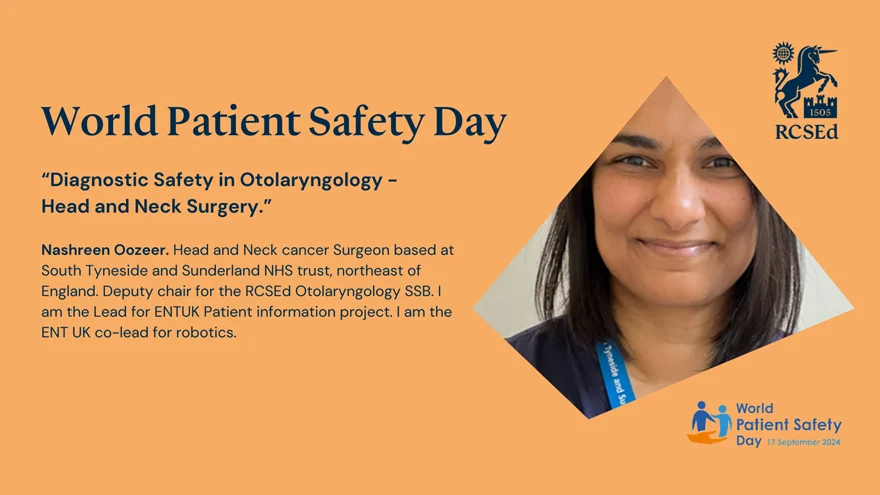
The Patient Safety Group (PSG) of the Royal College of Surgeons of Edinburgh (RCSEd) are delighted to lend our enthusiastic support to the sixth World Patient Safety Day (WPSD). This event, established by the World Health Organisation (WHO) in 2019, takes place on 17 September every year. It helps to raise global awareness amongst all stakeholders about key Patient Safety issues and foster collaboration between patients, health care workers, health care leaders and policy makers to improve patient safety. Each year a new theme is selected to highlight a priority patient safety area for action.
The theme set by the WHO for this year’s WPSD is “Improving diagnosis for patient safety”, recognising the vital importance of correct and timely diagnosis in ensuring patient safety and improving health outcomes.
Streamlining of services is part of the initiatives within Otolaryngology Head and Neck Surgery (Ear Nose and Throat Surgery or ENT) to improve diagnostic safety, patient care and patient journey through earlier diagnosis. This leaner way of working makes the diagnostic pathway faster, more efficient, more sustainable as it reduces unnecessary steps in the pathway and unnecessarily waste of resources which can be redirected elsewhere. It reduces the need for multiple appointments as all the relevant diagnostics such as a flexible nasolaryngoscopy and an ultrasound scan of the neck or a cone beam CT scan of the sinuses followed by starting the consent process for surgery can all be done in one sitting. There is less risk of loss of investigations (less so now that most of these are digitised), less risk of patients missing appointments if their letter does not arrive on time, and less delay in treatment pathways.
I will illustrate my point by giving you two examples of streamlined processes in the ENT department of the Northeast of England.
The introduction of the rapid access neck lump clinic within the ‘Adult with Suspected Head and Neck cancer pathway’ has led to a significant improvement in the cancer patient journey. A patient referred on the cancer pathway with a neck lump will be seen in the ENT clinic by a senior clinician for a clinical assessment within 14 days of referral by their GP. Most patients referred by GPs with a neck lump do not have a sinister mass and can be reassured and discharged on the same day. If clinically appropriate, some will have an ultrasound scan with or without a fine needle aspiration cytology or core biopsy for histology on the same day from the clinic. The ultrasound findings will determine if the patient is reassured and discharged on the same day or offered an urgent staging CT scan which is done within 48-72 hours in our unit or other investigation. Within a week, these patients will have been given a diagnosis of cancer which allows closure of the 28-day faster diagnosis pathway (introduced in April 2020). They can then move forward on their cancer journey with further investigations followed by MDT recommendation of a treatment plan.
Prior to introducing this rapid diagnostic pathway, we noted that GPs were organising neck ultrasound scans in the community where there is no access to FNA or core biopsy. These patients were not under any ENT clinician so could not be flagged to secondary care directly by the radiologist if an abnormal result was obtained. The patients, when GPs managed to get results of scans, would then be referred to and seen in secondary care by an ENT surgeon who would organise another ultrasound with targeted FNA or core biopsy. There has been a lot of pressure on radiology teams to provide duplicate scans and as you can see there are so many unnecessary steps and anxiety in the patient’s journey.
Within ENT, we have introduced similar streamlined pathway for patients referred with chronic rhinosinusitis who have not responded to maximum medical treatment in primary care setting despite advice and guidance to GPs by the ENT teams. Chronic rhinosinusitis is very commonly seen in the ENT clinics. In hospitals with access to a cone beam CT scan (CBCT), the patients who require a non-contrast CT scan of their sinuses can have the scan on the day, the images are reviewed with the clinician and if appropriate be consented for surgery on the day. Another example of use of the CBCT is for patients referred with suspected partial blockage of a salivary gland clinically who can be consented to have a floor of mouth CBCT to accurately localise the calculus or stone. Those with significant symptoms can be referred there and then for consideration of a sialendoscopy. Cone beam CT scans that can be done in the outpatient setting and has revolutionised the pathway of our non-cancer patients too. There is no need to wait on long radiology diagnostic waiting lists for a CT scan of the sinuses or floor of mouth.
Our goals as clinicians are to ensure timely and accurate diagnosis of our patients, use of limited NHS resources judiciously with no duplication of investigations, to allow these diagnostic resources to be redirected to other patients and ultimately, we all want to ensure provision of safe care to all patients.

